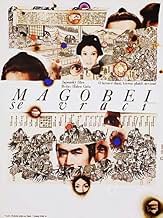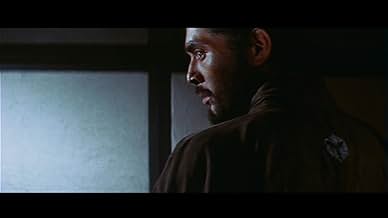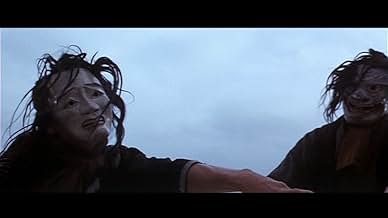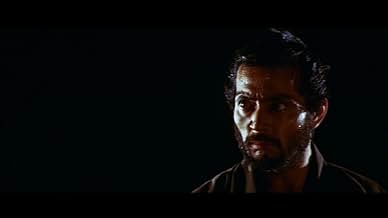CALIFICACIÓN DE IMDb
7.6/10
2.8 k
TU CALIFICACIÓN
Agrega una trama en tu idiomaA guilt-haunted samurai warrior attempts to prevent a massacre from taking place.A guilt-haunted samurai warrior attempts to prevent a massacre from taking place.A guilt-haunted samurai warrior attempts to prevent a massacre from taking place.
- Premios
- 2 premios ganados y 1 nominación en total
- Dirección
- Guionistas
- Todo el elenco y el equipo
- Producción, taquilla y más en IMDbPro
Opiniones destacadas
I saw "Goyokin" in 1969 at a small theater in Yokohama, Japan. It was in Japanese, of course, but the evolution of the story was understood. The film was so well done, and beyond what I was used to as an American watching Japanese movies in Japan. The acting was superb and the tension was palpable. The story was unique and its presentation was gorgeous. It's not hyperbole to say I was awestruck. With the advent of VHS I began searching for this movie as a video. After years of searching, I bought a barely watchable re-re-re-reprint with multiple subtitles. I was happy to HEAR the movie again! Tom ("Billy Jack") Loughlin made the putrid, displaced "The Master Gunfighter" but it was ludicrous as a Western. I will never understand why this classic has not been produced as a Video! Obviously, many people know about it, and it appears on wish lists throughout the world. It deserves the full DVD treatment and, PLEASE, while the great Tatsuya Nakadai is still alive to provide commentary on it.
I saw this film in the late 1970s. It was called "Goyekin - The Emperor's Gold". As I watched our guilt-ridden hero return to fulfill his promise, really a threat, to punish his family if they repeated their crime. I still see the image of him striding along the beach with a conical hat pulled low. The shadow on his face made his eyes glow under the hat and the shot was taken with a telephoto through wispy beach grass. Completely memorable. Then the scene in the forest with the horsemen riding through. It looked like an ancient Japanese painting with hazy colors and an other-worldliness that was amazing. Then the concluding duel in the snow. Two brilliantly attired samurai dueling in a pure white, glistening environment. So many great images from one film!
The film itself is a pretty typical revenge film with some twists. When Tom Laughlin tried to redo it as a Mexican western,"The Master Gunfighter", it just fell flat. But the samurai movie has an entertaining plot and good action characters with beautiful settings. I think this film is a special case of cinematographic excellence. See it and enjoy the beauty.
The film itself is a pretty typical revenge film with some twists. When Tom Laughlin tried to redo it as a Mexican western,"The Master Gunfighter", it just fell flat. But the samurai movie has an entertaining plot and good action characters with beautiful settings. I think this film is a special case of cinematographic excellence. See it and enjoy the beauty.
A remorseful samurai struggles to reconcile clan loyalty with honourable behaviour after turning a blind eye to the massacre of innocent villagers to cover up the theft of gold intended for the Tokugawa shogunate. Thematically similar to director Hideo Gosha's other chanbara, this film takes a hard look at the unquestioning obedience demanded of underlings in feudal societies and how the honour and fidelity can be manipulated to dishonorable and wicked ends. The three leads, Tatsuya Nakadai, Kinnosuke Nakamura, and Tetsuro Tamba, all well-established actors in Japanese cinema (both in jidaigeki and other genres), are excellent. The cinematography, which includes some fanciful imagery is great, the story interesting, and the 'action sequences' well-done and entertaining. All in all, a great entry in the popular genre from a top Japanese director.
Goyokin is one of those movies that I wanna scream from the rooftops just how incredibly awesome they are. The kind of film I wanna grab every person I know by the neck and force them to watch it with eyes wide open, Clockwork Orange style. It's really a cinematic crime that Goyokin is not as widely seen and regarded as the works of more famous Japanese directors, like Kurosawa. It might be a genre movie and as such attract mostly chambara fans, but this really deserves to reach more mainstream audiences. Put simply, if you like beautiful movies, you have to see this one.
The plot concerns a clan that is struggling financially who schemes to steal a shipment of the Shogun's gold and silence the nearby villagers who witness the crime and the ronin Magobei (played by the unparalleled Tatsuya Nakadai) who makes a moral stand and decides to go against his former clan. I won't go too far into plot details, but let's just say Goyokin is an anti-samurai film at heart. Like the best work of that other great jidai-geki director, Masai Kobayashi, Hideo Gosha doesn't try to pass moral judgement on his characters and treats them with compassion and affection. We're in 1830 and these are hard times for samurais as Japan finds herself on the brink of change. As one character realises in the end, "We sit here and die in the cold, and what does the Shogunate do? They get fatter in the heat". Gosha doesn't condemn the samurais for their soon to be obsolete code, rather puts things into perspective and shows us that desperate people will do desperate things. Innocent people die but who is really responsible for these crimes? It plays out like a good ancient Greek tradegy, minus the melodrama. Every emotion is incredibly nuanced here, every glance, move and frame. Gosha wisely lets the visuals tell the story.
And that brings me to the next point. The visuals. I am not exaggerating when I say that Goyokin is one of the most beautiful movies ever conceived. Yes better than most Kurosawa films, if the comparison has any merit. The colours are like small strokes of a brush on a white canvas as most of the film was shot outdoors in snowy landscapes. The rugged terrain is a pivotal character here, from the stormy sea to the blizzards to the open vistas. The cinematography and the way Gosha treats the locations as an integral part of every scene, reminded me of the spaghetti westerns of the great Sergio Corbucci (Django, The Great Silence). The muddy streets of a small town (as in Django). The snow blizzards and the cold, hostile terrain (as in The Great Silence). Samurais trying to prevent frostbite from setting in before a duel, unable to pick up their swords and fight. That nature is so tightly interwoven to the plot is another testament to Gosha's attention to detail. His cinematography is truly outstanding. I simply can't stress how visually awe-inspiring this movie is. Every frame is a painting. In a way it brought to mind the maestro Sergio Leone. After all the jidai-geki and the spaghetti western are very similar in the ways they depict their scarred heroes, the duel and the terrain.
I don't know what else to say about Goyokin. The performances are great all around with Ruriko Asaoka stealing every scene she's in, not least thanks to her drop dead gorgeous looks. Tatsuya Nakadai is once again outstanding in the lead role. The swordplay is fantastic, quick and brutal thrusts of the sword with an emphasis on the ritualistic aspect of the duel. The silence before and after. Although not as bloody and action-oriented as something like Lone Wolf and Cub, Goyokin left me more than satisfied in that department.
There's not much else to add, except that Goyokin is criminally underseen (judging by the amount of votes here). Maybe in the years to come western audiences will open up their horizons and realize what they've been missing. In the meantime if you're reading this, seek this movie out. You won't regret it.
The plot concerns a clan that is struggling financially who schemes to steal a shipment of the Shogun's gold and silence the nearby villagers who witness the crime and the ronin Magobei (played by the unparalleled Tatsuya Nakadai) who makes a moral stand and decides to go against his former clan. I won't go too far into plot details, but let's just say Goyokin is an anti-samurai film at heart. Like the best work of that other great jidai-geki director, Masai Kobayashi, Hideo Gosha doesn't try to pass moral judgement on his characters and treats them with compassion and affection. We're in 1830 and these are hard times for samurais as Japan finds herself on the brink of change. As one character realises in the end, "We sit here and die in the cold, and what does the Shogunate do? They get fatter in the heat". Gosha doesn't condemn the samurais for their soon to be obsolete code, rather puts things into perspective and shows us that desperate people will do desperate things. Innocent people die but who is really responsible for these crimes? It plays out like a good ancient Greek tradegy, minus the melodrama. Every emotion is incredibly nuanced here, every glance, move and frame. Gosha wisely lets the visuals tell the story.
And that brings me to the next point. The visuals. I am not exaggerating when I say that Goyokin is one of the most beautiful movies ever conceived. Yes better than most Kurosawa films, if the comparison has any merit. The colours are like small strokes of a brush on a white canvas as most of the film was shot outdoors in snowy landscapes. The rugged terrain is a pivotal character here, from the stormy sea to the blizzards to the open vistas. The cinematography and the way Gosha treats the locations as an integral part of every scene, reminded me of the spaghetti westerns of the great Sergio Corbucci (Django, The Great Silence). The muddy streets of a small town (as in Django). The snow blizzards and the cold, hostile terrain (as in The Great Silence). Samurais trying to prevent frostbite from setting in before a duel, unable to pick up their swords and fight. That nature is so tightly interwoven to the plot is another testament to Gosha's attention to detail. His cinematography is truly outstanding. I simply can't stress how visually awe-inspiring this movie is. Every frame is a painting. In a way it brought to mind the maestro Sergio Leone. After all the jidai-geki and the spaghetti western are very similar in the ways they depict their scarred heroes, the duel and the terrain.
I don't know what else to say about Goyokin. The performances are great all around with Ruriko Asaoka stealing every scene she's in, not least thanks to her drop dead gorgeous looks. Tatsuya Nakadai is once again outstanding in the lead role. The swordplay is fantastic, quick and brutal thrusts of the sword with an emphasis on the ritualistic aspect of the duel. The silence before and after. Although not as bloody and action-oriented as something like Lone Wolf and Cub, Goyokin left me more than satisfied in that department.
There's not much else to add, except that Goyokin is criminally underseen (judging by the amount of votes here). Maybe in the years to come western audiences will open up their horizons and realize what they've been missing. In the meantime if you're reading this, seek this movie out. You won't regret it.
I just had to write something when I saw that the current spotlighted user's comment calls this movie merely "decent." I just got back from seeing it on the big screen, and believe me, it's WAY more than "decent." More like amazing. I am truly grateful to have had the opportunity to see it. I'll be the first to admit that it's at times narratively challenging, and that the main character is fairly one-note. But it really compares in many respects with classic westerns like The Searchers. Plus a truly inventive, exciting, and striking climax. Full of visual poetry. Ten lines really does seem like a bit much to require people to write. Would six be so awful? All I really wanted to do was provide some balance to the "decent" comment. Wow. I'm still just at nine lines. Okay. See this on the big screen if you have a chance. It's truly a widescreen picture that uses the frame quite inventively at times. And that's eleven lines, so I'm done.
¿Sabías que…?
- TriviaThis is the first Japanese feature film in Panavision.
- ConexionesFeatured in Trailer Trauma V: 70s Action Attack! (2020)
Selecciones populares
Inicia sesión para calificar y agrega a la lista de videos para obtener recomendaciones personalizadas
- How long is The Steel Edge of Revenge?Con tecnología de Alexa
Detalles
- Tiempo de ejecución2 horas 4 minutos
- Mezcla de sonido
- Relación de aspecto
- 2.35 : 1
Contribuir a esta página
Sugiere una edición o agrega el contenido que falta

Principales brechas de datos
By what name was Los piratas de oro: tiranía (1969) officially released in Canada in English?
Responda




























